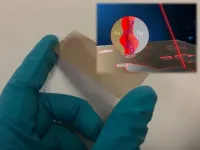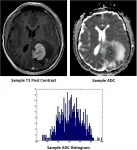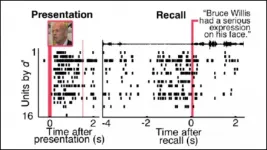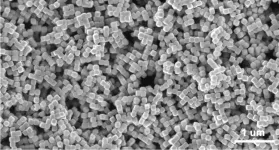INFORMATION:
The work was supported by the U.S. National Science Foundation.
University at Buffalo researchers report quantum-limit-approaching chemical sensing chip
Study shows improvements to chemical sensing chip that aims to quickly and accurately identify drugs and other trace chemicals
2021-01-11
(Press-News.org) BUFFALO, N.Y. -- University at Buffalo researchers are reporting an advancement of a chemical sensing chip that could lead to handheld devices that detect trace chemicals -- everything from illicit drugs to pollution -- as quickly as a breathalyzer identifies alcohol.
The chip, which also may have uses in food safety monitoring, anti-counterfeiting and other fields where trace chemicals are analyzed, is described in a study that appears on the cover of the Dec. 17 edition of the journal Advanced Optical Materials.
"There is a great need for portable and cost-effective chemical sensors in many areas, especially drug abuse," says the study's lead author Qiaoqiang Gan, PhD, professor of electrical engineering in the UB School of Engineering and Applied Sciences.
The work builds upon previous research Gan's lab led that involved creating a chip that traps light at the edges of gold and silver nanoparticles.
When biological or chemical molecules land on the chip's surface, some of the captured light interacts with the molecules and is "scattered" into light of new energies. This effect occurs in recognizable patterns that act as fingerprints of chemical or biological molecules, revealing information about what compounds are present.
Because all chemicals have unique light-scattering signatures, the technology could eventually be integrated into a handheld device for detecting drugs in blood, breath, urine and other biological samples. It could also be incorporated into other devices to identify chemicals in the air or from water, as well as other surfaces.
The sensing method is called surface-enhanced Raman spectroscopy (SERS).
While effective, the chip the Gan group previously created wasn't uniform in its design. Because the gold and silver was spaced unevenly, it could make scattered molecules difficult to identify, especially if they appeared on different locations of the chip.
Gan and a team of researchers -- featuring members of his lab at UB, and researchers from the University of Shanghai for Science and Technology in China, and King Abdullah University of Science and Technology in Saudi Arabia -- have been working to remedy this shortcoming.
The team used four molecules (BZT, 4-MBA, BPT, and TPT), each with different lengths, in the fabrication process to control the size of the gaps in between the gold and silver nanoparticles. The updated fabrication process is based upon two techniques, atomic layer deposition and self-assembled monolayers, as opposed to the more common and expensive method for SERS chips, electron-beam lithography.
The result is a SERS chip with unprecedented uniformity that is relatively inexpensive to produce. More importantly, it approaches quantum-limit sensing capabilities, says Gan, which was a challenge for conventional SERS chips
"We think the chip will have many uses in addition to handheld drug detection devices," says the first author of this work, Nan Zhang, PhD, a postdoctoral researcher in Gan's lab. "For example, it could be used to assess air and water pollution or the safety of food. It could be useful in the security and defense sectors, and it has tremendous potential in health care."
ELSE PRESS RELEASES FROM THIS DATE:
Research finds increased first-trimester exercise may reduce gestational diabetes risk
2021-01-11
Pregnant women who exercise more during the first trimester of pregnancy may have a lower risk of developing gestational diabetes, according to a new study led by Samantha Ehrlich, an assistant professor in the Department of Public Health at the University of Tennessee, Knoxville, and adjunct investigator with the Kaiser Permanente Division of Research. The analysis found that lower risk was associated with at least 38 minutes of moderate intensity exercise each day--a bit more than current recommendations of at least 30 minutes a day five days a week.
Gestational diabetes refers to diabetes diagnosed for the first time during pregnancy. It can pose serious health problems including pregnancy and delivery complications as well as increased future risk for diabetes ...
Oncotarget: HIV +/- patients with lymphoma as a predictor of outcome & tumor proliferation
2021-01-11
The cover for issue 45 of Oncotarget features Figure 3, "Representative images of whole tumor volume segmentation of the co-registered T1 post-contrast sequence and apparent diffusion coefficient (ADC) map, yielding the corresponding ADC histogram distribution utilized for data analysis," recently published in "Diffusion-weighted MR imaging histogram analysis in HIV positive and negative patients with primary central nervous system lymphoma as a predictor of outcome and tumor proliferation" by Khan, et al.
This authors reported that the aim of this study is to investigate the correlation between ...
Imagining a face reactivates face-detecting neurons in humans
2021-01-11
Face-sensitive neurons in humans employ distinct activity patterns to encode individual faces; those patterns reactivate when imagining the face, according to research recently published in JNeurosci.
Human social interaction hinges on faces. In fact, faces are so important that the brain contains entire regions in the ventral temporal cortex devoted to facial recognition. In humans, the fusiform facial area activates in response to faces, and monkeys have single neurons that fire when shown a face. However, experimental limitations have prevented us from knowing how the human brain responds to and processes faces at the level of the single neuron.
To close this gap, Khuvis et al. measured the electrical activity of neurons in the ventral temporal ...
Rice model offers help for new hips
2021-01-11
HOUSTON - (Jan. 11, 2021) - Rice University engineers hope to make life better for those with replacement joints by modeling how artificial hips are likely to rub them the wrong way.
The computational study by the Brown School of Engineering lab of mechanical engineer Fred Higgs simulates and tracks how hips evolve, uniquely incorporating fluid dynamics and roughness of the joint surfaces as well as factors clinicians typically use to predict how well implants will stand up over their expected 15-year lifetime.
The team's immediate goal is to advance the design of more robust prostheses.
Ultimately, they say the model could help clinicians personalize hip joints for patients depending on gender, ...
UVA-led team expands power grid planning to improve system resilience
2021-01-11
In most animal species, if a major artery is cut off from the heart, the animal will struggle to survive. The same can be said for many of our critical infrastructure systems, such as electric power, water and communications. They are networked systems with vulnerable connections.
This vulnerability was on display in September 2017 when Hurricane Maria wrecked Puerto Rico's electric power grid, leaving almost all of the island's 3.3 million people without electricity. The months-long blackout that followed was the worst in U.S. history.
Claire Trevisan, ...
Oncotarget: PD-1/PD-L1 expression in anal squamous intraepithelial lesions
2021-01-11
Oncotarget recently published "PD-1/PD-L1 expression in anal squamous intraepithelial lesions" which reported that the presence and distribution of CD8 lymphocytes and the presence of PD-1 lymphocytes and PD-L1 epithelial cells were assessed.
CD8 lymphocytes were observed more frequently in HSIL versus LSIL in the lamina propria or intra epithelial.
PD-1 lymphocytes were observed more frequently in HSIL versus LSIL.
There was no difference between HSIL and LSIL for PD-L1 epithelial cells.
Anal dysplastic lesions are accompanied by an inflammatory lymphocytic infiltrate expressing CD8 and PD-1, more frequent in high-grade lesions.
Dr. ...
Researchers develop new one-step process for creating self-assembled metamaterials
2021-01-11
A team led by University of Minnesota Twin Cities researchers has discovered a groundbreaking one-step process for creating materials with unique properties, called metamaterials. Their results show the realistic possibility of designing similar self-assembled structures with the potential of creating "built-to-order" nanostructures for wide application in electronics and optical devices.
The research was published and featured on the cover of Nano Letters, a peer-reviewed scientific journal published by the American Chemical Society.
In general, metamaterials are materials made in the lab so as to provide specific physical, chemical, electrical, and optical properties otherwise impossible to find in naturally occurring materials. These materials can ...
Carbon monoxide reduced to valuable liquid fuels
2021-01-11
HOUSTON - (Jan. 11, 2021) - A sweet new process is making sour more practical.
Rice University engineers are turning carbon monoxide directly into acetic acid -- the widely used chemical agent that gives vinegar its tang -- with a continuous catalytic reactor that can use renewable electricity efficiently to turn out a highly purified product.
The electrochemical process by the labs of chemical and biomolecular engineers Haotian Wang and Thomas Senftle of Rice's Brown School of Engineering resolves issues with previous attempts to reduce carbon monoxide (CO) into acetic acid. Those processes required additional steps to purify ...
Study finds Dense Breast Notification legislation has not met all desired goals
2021-01-11
(Boston)--Little previous research has examined the effects of Dense Breast Notifications (DBNs), but a new study suggests the legislatively required notifications have achieved partial success: women living in states in which in DBNs are mandated had higher rates of being informed about personal breast density and of having had breast density discussions with providers, though rates were low overall.
DBNs are a written notification to a woman after a mammogram with information about breast density. The goal is to motivate her to speak with her doctor about her personal risk and determine if supplemental screening for breast cancer is appropriate. DBNs are mandated in more than 38 states and the Food Drug ...
Scientists make sustainable polymer from sugars in wood
2021-01-11
Scientists from the University of Bath have made a sustainable polymer using the second most abundant sugar in nature, xylose.
Not only does the new nature-inspired material reduce reliance on crude oil products, but its properties can also be easily controlled to make the material flexible or crystalline.
The researchers, from the University's Centre for Sustainable and Circular Technologies, report the polymer, from the polyether family, has a variety of applications, including as a building block for polyurethane, used in mattresses and shoe soles; as a bio-derived alternative to polyethylene glycol, a chemical widely used in bio-medicine; or to polyethylene oxide, ...
LAST 30 PRESS RELEASES:
HKUST Engineering researchers developed a novel photodetector to enhance the performance of on-chip light monitoring
Strategic river sensors could have forewarned of Texas Camp flood disaster
Drone sampling of whale breath reveals first evidence of potentially deadly virus in Arctic
Roman soldiers defending Hadrian’s Wall infected by parasites, study finds
Pinochet’s prisoners were tormented with music but still found solace in it, a new book reveals
Fertility remains high in rural Tanzania despite access to family planning
AI-assisted device can improve autism care access
Kinetic careers
Uncovering how parasitic plants avoid attacking themselves to improve crop resistance
Nanoparticle vaccine strategy could protect against Ebola and other deadly filoviruses
Study finds brain care score can predict risk of stroke across racial groups
Key lung immune cells can intensify allergic reactions
Do hormones explain why women experience more gut pain?
New materials conduct ions in solids as easily as in liquids
Breakthrough of the Year: Renewable energy begins to eclipse fossil fuel-based sources
LLM use is reshaping scientific enterprise by increasing output, reducing quality and more
Introducing LightGen, a chip for ultra-fast, ultra-efficient generative AI
Astronomers see fireworks from violent collisions around nearby star
ACC/AHA issue new guideline on managing congenital heart disease in adults
Cosmic crash caught on camera
Is talented youth nurtured the wrong way? New study shows: top performers develop differently than assumed
Ants: An untapped resource in the development of antibiotics?
Archaeologists use AI to create prehistoric video game
Mitochondria migrate toward the cell membrane in response to high glucose levels
Tiny viral switch offers hope against drug-resistant bacteria
Most parents aware of early peanut introduction guidelines, but confused about details
HPV vaccine can protect against severe lesions of the vulva and vagina
Virtual care provision and emergency department use among children and youth
Quadrivalent HPV vaccine and high-grade vulvovaginal lesions
Insights into dry eyes gained from stem cell-derived tear glands
[Press-News.org] University at Buffalo researchers report quantum-limit-approaching chemical sensing chipStudy shows improvements to chemical sensing chip that aims to quickly and accurately identify drugs and other trace chemicals






